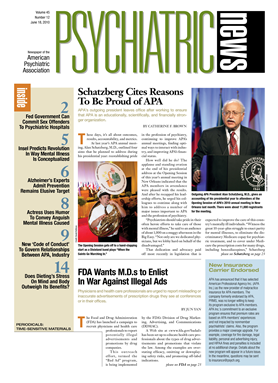It is truly a privilege to be your president. I look forward to an exciting year ahead and hope to work with all of you to lead our Association in a direction that will be productive, effective, and efficient at meeting the needs of our patients and our membership.
In my nearly 30 years of involvement in APA, I have had the opportunity to view our work from many different perspectives. Beginning as a resident, my participation was driven by a desire to improve access to care for patients in New York City. I subsequently worked with my local district branch, my state organization, the Assembly, and ultimately the Board of Trustees. I also chaired several committees related to my career in psychiatric education. I looked up to teachers and supervisors who were active in the organization and viewed the mission of APA as central to my identity as a psychiatrist.
Through these years, a constant theme for elected leadership and staff at both the national and local levels has revolved around these questions: What do our members really want? What issues are of most importance? What are our key priorities? Given the diversity of membership, these questions have been difficult to answer since we represent many constituencies—individual private practice, academia, the public sector, the subspecialties of psychiatry, and many more.
We have made a number of attempts to “reorganize” and to clarify our goals. Our younger members are less inclined to join organizations, more inclined to link with their subspecialty groups, and place a high value on work-life balance that limits energy and resources available to work outside of standard jobs. I have held a series of “town halls” throughout the past year to better understand younger members' issues and concerns. With the assistance of the newly established Committee on Members in Training (CoMIT), I will be reviewing all of the comments from these town halls and prioritizing those to implement. However, it is quite clear that one of the key concerns of our young colleagues is the need for mentorship. I hope to establish cross-cutting mentorship programs that will connect national leaders with local leaders across affinity groups to facilitate cross-generational collaboration.
Advances in technology hold the promise of new ways to engage our membership without requiring extensive travel. However, we still grapple with how to be most relevant and effective.
In the next year, I plan to work with our current leaders, including Drs. Alan Schatzberg and John Oldham, as well as Dr. Jay Scully, national staff, and representatives from our district branches and the Assembly to figure out how to meet these challenges. APA is fundamentally an educational organization with a mission to educate our members, our legislators, and the general public. We must continue to address stigma; help ensure that patients have sufficient, nondiscriminatory access to effective psychiatric care; provide our members with the latest scientific information to enhance their practices; and continue to work with our legislators both locally and nationally to assure the implementation of parity.
Our current governance structure is unwieldy and inefficient. We must think of creative ways to bring issues of local importance to the attention of our Board of Trustees and to bring some of the resources available at the national level back to our state associations and district branches. At the recent Assembly meeting in New Orleans (see
Assembly Tackles Patient Care, Professional Issues), I challenged each district branch to identify the three issues of most concern to its local members. I have also asked that the Areas and the Assembly Executive Committee distill these issues to a total of 10 by the end of the summer so that the Board of Trustees can use this information to strategize for 2010-2011.
In September, I will work with the Board to identify strategic goals for my presidential year and develop programs and services that derive from them. These goals in turn will be disseminated to the Assembly, councils, and other components immediately afterward to facilitate discussions across the Association regarding priorities and projects. Such communication within APA has been suboptimal, which has limited our ability to be as effective and efficient as we would like. As we continue to refine our organizational structure and be more accountable to the membership and our patients, I would like to work with you to assure the success of this approach.
We can succeed at this task and have a profound impact if we each do our own small part to ensure that those suffering from psychiatric disorders have access to the best possible psychiatric care, benefit from the most recent research and treatment strategies, and are able to live productive and useful lives as citizens. This isn't just about my leadership—it is about our leadership for our profession, for our patients, and for the general public.
I welcome your suggestions and comments in this process. Please e-mail them to me at
[email protected].


